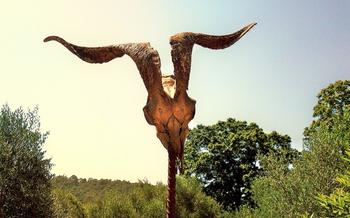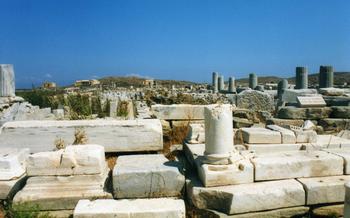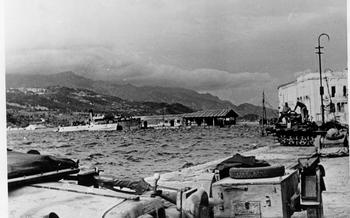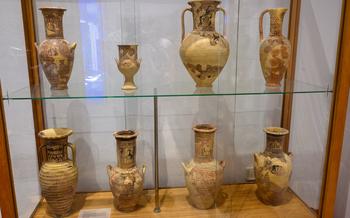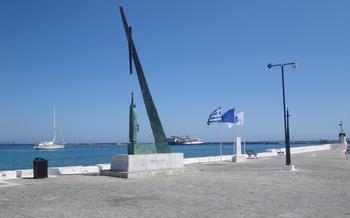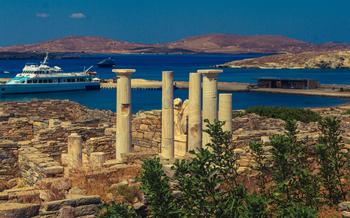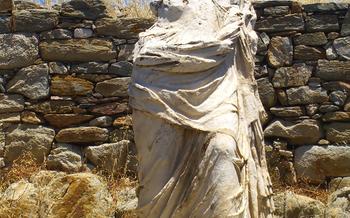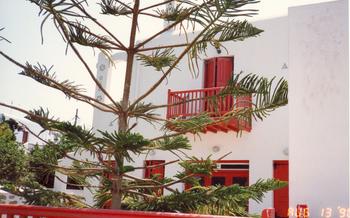
Archaeological Site of Mili
- A Journey Through Time: Exploring the Archaeological Site of Mili
- Unearthing the Ancient City of Mili
- Strolling Through the Ruins of Mili
- Fortifications and Gates: Protecting the City of Mili
- Public Buildings: Civic and Social Centers
- The Theater of Mili: A Stage for Performances and Celebrations
- Mosaics and Frescoes: Glimpses of Artistic Expression
- Olive Oil Production in Ancient Mili
- Water Management Systems: Engineering Marvels of Ancient Times
- The Necropolis of Mili: Eternal Resting Places
- The Museum of Samos: A Treasure Trove of Archaeological Discoveries
- Planning Your Visit: Practical Tips for a Rewarding Experience
- Capturing the Essence of Mili: Photography Tips and Inspiration
- Insider Tip: Unveiling Hidden Gems
A Journey Through Time: Exploring the Archaeological Site of Mili
Embark on a captivating journey through history as you step into the Archaeological Site of Mili, a treasure trove of ancient ruins and artifacts nestled on the picturesque island of Samos, Greece. This remarkable site offers a glimpse into the rich past of the island, inviting you to explore the remnants of an ancient city that once thrived on these shores.
Located just a short drive from the vibrant town of Pythagoreio, the Archaeological Site of Mili is easily accessible by car or public transportation. As you approach the site, you'll be greeted by a breathtaking panorama of rolling hills, sparkling turquoise waters, and the distant silhouette of the Turkish coastline. Prepare to be transported back in time as you wander among the ruins, uncovering the secrets of a civilization that flourished centuries ago.
Unearthing the Ancient City of Mili
The ancient city of Mili, once a thriving settlement on the island of Samos, holds a rich history dating back to the 6th century BC. Founded by Ionians from Miletus, this city quickly rose to prominence as a significant cultural and economic center. Its strategic location on the northeast coast of Samos made it a vital port city, facilitating trade and cultural exchange with neighboring regions.
Inhabitants of Mili were known for their skills in agriculture, particularly in the cultivation of olives and grapes. The city's fertile lands and favorable climate contributed to its prosperity, as evidenced by the impressive remains of olive presses and winemaking facilities discovered at the archaeological site.
Mili played a vital role in the religious and political landscape of ancient Samos. It was home to several temples dedicated to Greek deities, including Hera, Zeus, and Apollo. These temples served as centers of worship and pilgrimage, attracting devotees from across the island and beyond.
The city's political significance is reflected in the discovery of the Bouleuterion, a council house where civic matters were discussed and decisions were made. This building, along with other public structures, testifies to the organized and well-governed nature of Mili.
As archaeologists continue to excavate and study the ruins of Mili, new insights into the daily lives of its inhabitants are constantly emerging. From the foundations of houses and shops to the intricate mosaics adorning public buildings, every discovery sheds light on the vibrant and sophisticated society that once flourished in this ancient city.
Strolling Through the Ruins of Mili
As you wander through the ruins of Mili, the ancient city's layout reveals itself. Streets once bustling with life now lie silent, but their outlines are still discernible. Squares, once the gathering places of the community, now stand empty, their cobblestones worn smooth by the passage of time. Neighborhoods, where families and friends resided, can still be traced, their boundaries marked by the remains of houses and shops.
Among the highlights of the site is the Agora, the city's central marketplace. Here, vendors would have set up their stalls, selling everything from fresh produce to handcrafted goods. The Agora was also a place for social interaction and political debate, the heartbeat of the ancient city.
Several temples dedicated to various deities have been discovered at Mili, each with its own unique architectural style and history. These temples were not just places of worship but also centers of religious rituals and festivals, bringing the community together in devotion and celebration.
The theater of Mili is another impressive structure. Built on a hillside, it offered spectators a breathtaking view of the surrounding landscape. The tiers of seats, carefully carved into the rock, provided ample space for the audience to enjoy performances that ranged from plays and musical events to religious festivals.
Fortifications and Gates: Protecting the City of Mili
Mili's defensive structures stand as a testament to the city's strategic importance and its need for protection against external threats. The city walls, with their imposing towers and fortified gates, formed a formidable barrier against invaders. These walls were constructed using large blocks of stone, carefully fitted together without the use of mortar. The towers, strategically positioned along the walls, provided vantage points for guards to keep watch for approaching enemies.
The gates of Mili were not merely points of entry and exit but also served as defensive checkpoints. The main gate, located on the western side of the city, was particularly impressive, featuring a massive archway flanked by two towers. Smaller gates were located at various points along the walls, allowing access to different neighborhoods of the city. The gates were equipped with heavy wooden doors and iron bars, which could be closed and locked in times of danger.
Exploring the gates of Mili is a fascinating journey through the city's ancient defenses. Each gate tells a story of resilience and determination, offering a glimpse into the lives of the people who once relied on these fortifications for their safety and security.
Public Buildings: Civic and Social Centers
The ancient city of Mili boasted a range of impressive public buildings that served as centers of civic life and social interaction. Among these structures, the Bouleuterion, Gymnasium, and Baths stand out as testaments to the city's advanced urban planning and cultural sophistication.
The Bouleuterion, or council house, was the seat of local government and a venue for political debates and decision-making. Constructed in the 4th century BC, it featured a large, rectangular hall with tiered seating, allowing citizens to attend and participate in public assemblies.
The Gymnasium, dedicated to physical training and education, played a vital role in the lives of young men in ancient Mili. Comprising a palestra for wrestling and other sports, as well as facilities for bathing and socializing, the Gymnasium fostered a culture of physical fitness and intellectual development.
Public Baths, an essential part of ancient Greek society, served not only for personal hygiene but also as social gathering places. The well-preserved remains of the Baths in Mili reveal intricate plumbing systems, communal pools, and private bathing chambers, highlighting the importance of cleanliness and social interaction in ancient life.
The Theater of Mili: A Stage for Performances and Celebrations
Carved into the hillside, overlooking the ancient city and the sparkling Aegean Sea, lies the Theater of Mili. This impressive structure is a testament to the cultural and artistic achievements of the ancient Milians. With its tiers of stone seats rising in concentric rows, the theater could accommodate thousands of spectators. The acoustics are remarkable, ensuring that every word spoken on stage could be heard even in the farthest corners of the auditorium.
The stage area is surrounded by a low wall, and behind it, one can see the remains of the skene, the building that served as a backdrop for performances. This elaborate structure likely featured columns, statues, and intricate paintings, creating a visually stunning setting for theatrical productions.
In ancient times, the theater was the hub of entertainment and cultural expression in Mili. It hosted a variety of performances, including plays, musical events, and religious festivals. The plays performed here were often comedies or tragedies, drawing inspiration from Greek mythology and history. Musicians and dancers also graced the stage, entertaining the audience with their talents.
During religious festivals, the theater transformed into a sacred space. Plays and rituals were performed in honor of the gods, and the audience participated in communal celebrations. The theater was a place where the community came together to celebrate their shared culture and traditions.
Even today, the Theater of Mili stands as a reminder of the vibrant cultural life that flourished in ancient Greece. Its ruins continue to inspire awe and wonder, inviting visitors to step back in time and experience the magic of live performances in this extraordinary setting.
Mosaics and Frescoes: Glimpses of Artistic Expression
As you wander through the ruins of Mili, keep an eye out for the remnants of ancient artistry in the form of mosaics and frescoes. These colorful and intricate artworks offer a glimpse into the creative spirit of the people who once inhabited this city.
Mosaic floors, with their vibrant colors and intricate designs, are a common feature of many ancient Greek cities, and Mili is no exception. These mosaics often depict mythological scenes, such as the battle between the gods and the giants, or everyday activities like hunting and fishing. The level of detail and craftsmanship in these mosaics is truly impressive, and they provide a valuable insight into the artistic skills of the ancient Greeks.
In addition to mosaics, Mili is also home to a number of well-preserved frescoes. These paintings, which were created using natural pigments, depict a variety of subjects, including religious scenes, mythological figures, and landscapes. The frescoes are often found on the walls of temples, public buildings, and private homes, and they offer a glimpse into the beliefs and values of the ancient Milians.
The mosaics and frescoes of Mili are a testament to the artistic talents of the ancient Greeks. These artworks not only beautified the city but also served to educate and entertain its inhabitants. By studying these works of art, we can gain a deeper understanding of the culture and history of this ancient civilization.
Olive Oil Production in Ancient Mili
The ancient city of Mili was renowned for its thriving olive oil industry, a testament to the region's rich agricultural heritage. Scattered throughout the archaeological site are remnants of olive presses and storage facilities, providing a glimpse into the production and importance of this liquid gold in ancient times.
Olive oil held immense economic value in ancient Greece, serving as a primary source of income for many communities. Its versatility extended beyond culinary purposes, as it was also used for lighting, religious rituals, and medicinal applications. The production of olive oil in Mili was a meticulous process that involved harvesting olives, pressing them to extract the oil, and storing it in large clay jars or amphorae.
The olive oil produced in Mili was highly prized for its exceptional quality and flavor, attributed to the region's unique climate and soil conditions. It was exported throughout the Mediterranean and beyond, contributing to the city's economic prosperity and establishing its reputation as a center of olive oil production.
In ancient Greek culture, olive oil held significant religious symbolism. It was associated with the goddess Athena, who was believed to have gifted the olive tree to mankind. Olive oil was used in religious ceremonies, including libations and offerings to the gods, and was considered a sacred substance.
Today, olive oil production remains a vital part of the economy and culture of Samos. Visitors to the island can immerse themselves in this tradition by visiting olive groves, witnessing the olive harvest, and sampling the locally produced olive oil, which continues to be celebrated for its exceptional quality and flavor.
Water Management Systems: Engineering Marvels of Ancient Times
Among the impressive ruins of Mili, the ancient water management systems stand as testaments to the engineering prowess of its inhabitants. Aqueducts, skillfully crafted to channel water from distant sources, brought life-giving water to the city. These feats of engineering ensured a reliable water supply, sustaining the population and supporting agricultural activities.
Cisterns, strategically positioned throughout the city, collected and stored rainwater for use during dry spells. These underground reservoirs were essential for conserving water, particularly during the hot summer months. Their construction demonstrates the foresight and planning of the ancient Milians, who understood the importance of water security.
Fountains and canals further enhanced the water management system. Public fountains provided access to clean drinking water for residents and travelers alike. Canals, ingeniously designed to distribute water for irrigation, transformed the surrounding landscape into fertile fields. These water management systems not only supported the daily needs of the population but also contributed to the city's economic prosperity and agricultural success.
The ancient Milians' mastery of water engineering is evident in the sophisticated design and functionality of these systems. Their understanding of hydrology and hydraulics allowed them to create sustainable water management practices that ensured the city's flourishing for centuries. As visitors explore the ruins of Mili, they cannot help but marvel at the ingenuity and foresight of its ancient builders, who left behind a legacy of engineering marvels that continue to inspire and amaze.
The Necropolis of Mili: Eternal Resting Places
Beyond the bustling streets and impressive structures of ancient Mili lies a serene realm where the city's inhabitants found their final resting place—the necropolis. Scattered around the outskirts of the site, these ancient cemeteries offer a glimpse into the funerary customs and beliefs of the Milians.
Various types of tombs can be found within the necropolis, each reflecting the social status and cultural practices of the deceased. Chamber tombs, carved into the soft rock of the hillsides, provided spacious and elaborate burial chambers for prominent individuals and families. Rock-cut graves, simpler in design, were used for more common burials. Tumuli, earthen mounds covering stone-lined chambers, were also prevalent, particularly during the Hellenistic period.
The Milians held elaborate funerary rituals to honor their departed loved ones. Bodies were carefully prepared and adorned with grave goods, such as jewelry, pottery, and personal items, believed to accompany the deceased into the afterlife. Inscriptions on tombstones and stelae provide valuable insights into the names, families, and occupations of the buried individuals, offering a glimpse into the social structure of ancient Mili.
Exploring the necropolis is a poignant experience, allowing visitors to connect with the lives and deaths of the ancient Milians. While death may have marked the end of their earthly existence, their resting places serve as a testament to their enduring presence in the history and memory of this ancient city.
The Museum of Samos: A Treasure Trove of Archaeological Discoveries
Nestled in the heart of Vathy, the capital of Samos, the Museum of Samos stands as a testament to the island's rich history and cultural heritage. Within its walls, a wealth of archaeological treasures from the ancient city of Mili and other significant sites across Samos awaits exploration.
The museum's collection is a captivating journey through time, showcasing artifacts that tell the story of Samos' past. Sculptures of gods and goddesses, intricately carved and weathered by time, evoke the spiritual beliefs of the ancient Samians. Alongside these divine figures, a vast array of pottery, from delicate vases to utilitarian jars, provides a glimpse into the everyday lives of the island's inhabitants.
Exquisite jewelry, crafted with precision and adorned with precious stones, sparkles within the museum's displays, hinting at the opulence and artistry of ancient Samian society. Inscriptions, etched in stone and metal, offer tantalizing fragments of history, revealing names, dates, and glimpses into the political and social structures of the island.
Interactive displays and educational programs at the Museum of Samos bring the ancient world to life, engaging visitors with the history and culture of Samos in a dynamic and immersive manner. Through touchscreens, multimedia presentations, and hands-on activities, the museum fosters a deeper understanding of the island's past, making it an essential stop for anyone seeking to delve into the depths of Samian history.
Planning Your Visit: Practical Tips for a Rewarding Experience
To ensure a rewarding visit to the Archaeological Site of Mili, careful planning is essential. Here are some practical tips to help you make the most of your experience:
-
Best Time to Visit: The ideal time to visit Mili is during the shoulder seasons, from April to May and September to October. During these months, the weather is generally pleasant, with warm days and cool evenings. You can avoid the summer crowds and enjoy a more peaceful exploration of the site.
-
Guided Tours: To delve deeper into the history and significance of Mili, consider joining a guided tour. Experienced guides can provide valuable insights into the archaeological discoveries, the daily lives of the ancient inhabitants, and the cultural significance of the site. Guided tours are typically offered in multiple languages and can be pre-booked or arranged on-site.
-
Facilities and Amenities: The Archaeological Site of Mili is equipped with essential visitor facilities to enhance your experience. A visitor center provides information about the site, including maps, brochures, and historical context. Restrooms are available for convenience, and the site is wheelchair accessible, allowing visitors with disabilities to explore the ruins and enjoy the panoramic views.
Capturing the Essence of Mili: Photography Tips and Inspiration
The Archaeological Site of Mili offers a photographer's paradise, with its ancient ruins, panoramic views, and stunning natural surroundings. To capture the essence of this remarkable place, consider the following tips:
-
Harness the Golden Hours: Aim to visit the site during the early morning or late evening hours when the soft, golden light casts a warm glow on the ruins, creating an ethereal atmosphere.
-
Frame Your Shots: Use the natural elements of the landscape to frame your compositions. Position the ruins against the backdrop of the sparkling sea or the majestic mountains, creating a sense of depth and scale.
-
Explore Unique Perspectives: Don't be afraid to experiment with different angles and vantage points. Climb to higher ground to capture sweeping vistas or get up close to capture intricate details and textures of the ruins.
-
Embrace the Shadows: Embrace the play of light and shadow that dances across the ruins throughout the day. Shadows can add drama and depth to your images, highlighting the architectural features and creating a sense of mystery.
-
Capture the Spirit of the Place: While capturing the physical beauty of the site is important, don't forget to convey the spirit and atmosphere of Mili. Look for moments of tranquility, when the ruins seem to whisper stories of the past, or capture the vibrant energy of visitors exploring this ancient city.
Insider Tip: Unveiling Hidden Gems
Beyond the main attractions of the Archaeological Site of Mili, there are hidden gems waiting to be discovered. Venture off the beaten path to uncover lesser-known areas of the site that offer tranquility and stunning views. Explore the outskirts of the ruins, where you might stumble upon secluded corners with panoramic vistas of the surrounding landscape.
Take the time to wander through the nearby olive groves, where ancient trees stand as silent witnesses to the passage of time. Follow winding paths that lead to hidden coves and secluded beaches, where you can soak up the sun, swim in crystal-clear waters, and enjoy the serenity of nature.
Unveil the secrets of Mili by engaging with the locals. Strike up conversations with villagers who can share stories, legends, and insider tips about the area. They might guide you to hidden churches, traditional tavernas serving authentic Greek cuisine, or scenic spots that only locals know about.
Remember, the true essence of Mili lies not only in its ruins and artifacts but also in its hidden corners and the warmth of its people. Embrace the spirit of discovery and let your curiosity lead you to unforgettable experiences that will make your visit to Mili truly special.
